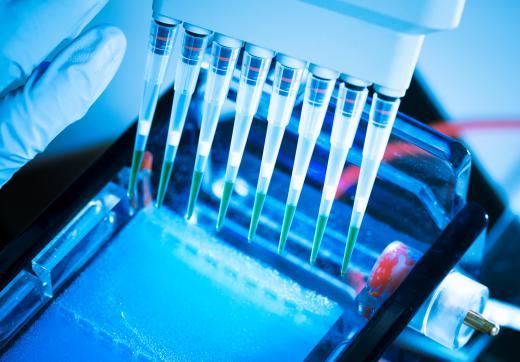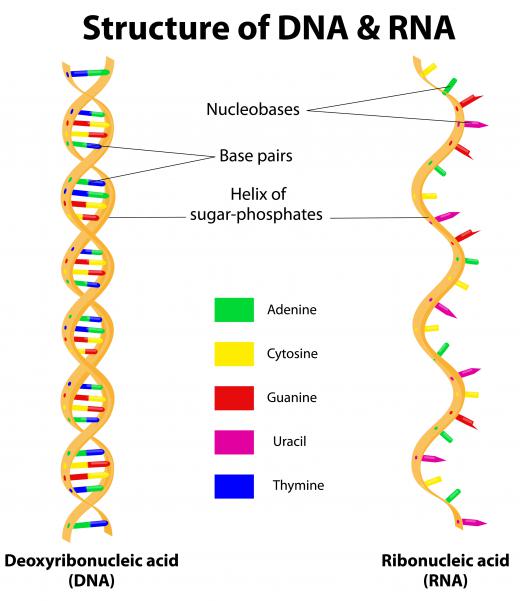What Is RNA Gel Electrophoresis?
In biochemistry, RNA gel electrophoresis is a common method used to analyze the biological molecule called ribonucleic acid (RNA). Gel electrophoresis separates molecules by size and charge as they are “sieved” through a sheet made from a gelatinous chemical substance. This process is most often employed in laboratories to analyze fragments of deoxyribonucleic acid (DNA) or RNA, molecules that contain an organism’s genetic information. RNA gel electrophoresis differs slightly from DNA gel electrophoresis in procedure, since RNA molecules, unlike DNA, are single-stranded chains that tend to fold into structures. This makes separation by size more difficult for RNA fragments.
The first step in RNA gel electrophoresis is the isolation of RNA molecules from the sample biological cells. The sample tissue is dissolved in a specific mixture of chemicals and purified to remove the enzyme RNase, proteins, and DNA. It is especially important that the sample not be contaminated with RNase at any point in the process, because RNase catalyzes the degradation of RNA molecules, causing them to break apart. After the sample is purified, it is chilled and another chemical is added to make the RNA precipitate, or drop as a solid out of the solution. The sample is then put into a centrifuge, which spins it at a high speed and isolates the solid precipitate at the bottom of the sample tube.

In a DNA or RNA gel electrophoresis procedure, the purified biological molecules are added to wells in one end of a flat gel sheet. An electric current is then run through the gel. Since DNA and RNA molecules are negatively charged, they are attracted to the positive electrode at the far end of the gel, and migrate through the pores in the gel towards that end. The pores in the gel are of a fixed size, so smaller fragments of the DNA or RNA migrate more quickly than larger fragments, which have more trouble navigating through the porous matrix.

After the gel has been run for a specified amount of time, the electric current is shut off and the results are examined. The DNA or RNA molecules can be stained and made visible at this point. Each fragment will appear as a band at a different point in the gel, depending on how far it was able to migrate given its size. The separation of fragments by size can be useful in comparing samples, as in forensics, to determine if there is a match — identical samples will have identical band patterns.
In RNA gel electrophoresis, the additional step of denaturing is required before the gel can be run. Under normal conditions, RNA molecules will clump or fold into secondary structures, affecting the mobility of the RNA fragments through the gel. To prevent this from occurring, the RNA sample must be denatured by adding a chemical, such as formaldehyde, to the sample and the gel.
AS FEATURED ON:
AS FEATURED ON:












Discuss this Article
Post your comments